Sonography of the Breast
One in nine women will develop breast cancer during her lifetime, provided she lives to age 85. Most breast cancer is NOT genetically linked – less than 16%. In the study by Stavros et al., July 1995, – over 80% of all sonographic, biopsy proven, solid nodules were benign.
Indications
Breast ultrasound is a diagnostic rather than a screening procedure; it is targeted to a specific clinical or focal mammographic finding in the vast majority of patients. Breast ultrasound should be performed on palpable lumps when the mammogram in the area of the lump is negative or nonspecific. Although, there are now a few studies on whole breast screening ultrasound.
Equipment
Breast ultrasound must have excellent spatial and contrast resolution. Both the axial and lateral components of spatial resolution must be good. Broadband, high frequency linear electronically focused probes currently offer the best combination of spatial and contrast resolution for breast ultrasound.
Axial Resolution
Excellent axial resolution is important in identifying normal structures which course parallel to the skin (such as mammary ducts and the fascial planes surrounding the mammary zone) and in identifying the characteristics of the capsules around cysts and solid nodules.
Lateral Resolution
Lateral resolution at all depths within the breast is important in order to minimize volume averaging of surrounding normal breast tissues with pathological lesions. Such volume averaging may cause mischaracterization of small cystic lesions as solid and may even cause small solid lesions to be indistinguishable from surrounding tissues. Lateral spatial resolution is also a complex subject. For linear probes there are two planes which determine lateral resolution; the long axis and short axis (elevation plane focus).
The long axis of the linear probe can be electronically focused. Continuous electronic focusing may be done on receive or transmit phases. The degree of electronic focusing upon receive depends upon many factors, including:
- number of channels
- aperture size
- number of elements
- number of scan lines
- apodization
In general lateral resolution improves with increasing; the number of channels, aperture size, number of elements in the transducer and scan lines. Electronic focusing on transmit depends on many of the same factors as receive focusing, but is more limited. It depends upon the number of transmit zones. In general, the more transmit zones, the better the lateral resolution. However, increasing the number of transmit zones, decreases the frame rate. In general, multiple transmit focal zones in the first 2cm are very beneficial in breast sonography.
Elevation Plane
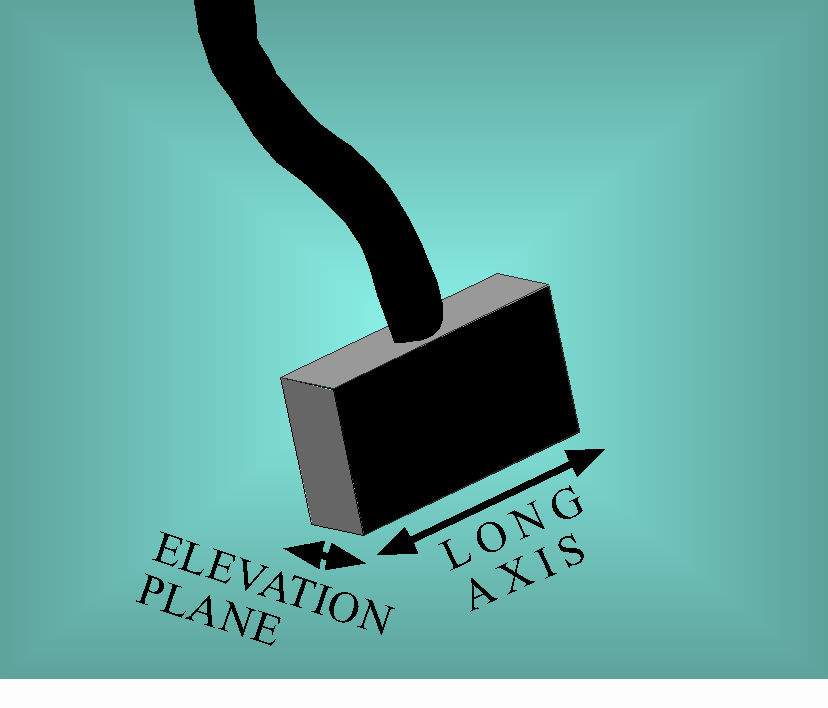
The elevation plane (short axis) of the probe cannot currently be electronically focused. The elevation plane is focused at a fixed depth by an acoustic lens. The manufacturer decides how deeply to focus this plane before the probe is built. Elevation plane, focal lengths are usually decided by the application for which the probe will primarily be used. Dedicated small parts or near field probes should be focused at about 1.5cm or even more superficially.
5MHz linear array probes were designed with peripheral vascular applications in mind and are focused in the elevation plane of about 3 to 4cm. This is too deep for most breast imaging, the elevation plane would be focused in the pectoralis muscle in most patients. In general a 7.5 to 13MHz transducer, with an elevation plane of about 1.5cm, is the best breast ultrasound transducer currently available.
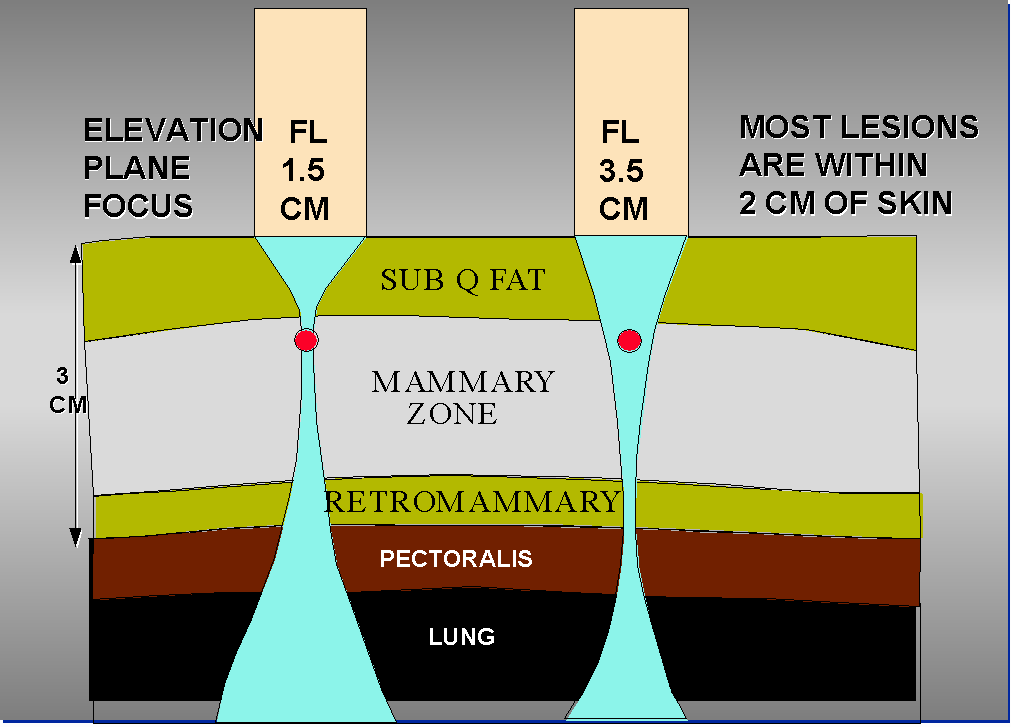
Above figure:
If a 5MHz transducer is used and the lesion of interest is small and superficial, volume averaging of adjacent normal tissues will be a problem. Cysts may fill-in and be misclassified as solid. Small solid lesions may be completely missed.

If a palpable nodule is pea or bee-bee sized, then it is very small and near the skin. In such cases, even optimally focused transducers may have difficulty resolving and characterizing the lesion. In such circumstances, the sonographer should use a 1cm standoff pad or a large "glop" of gel in order to move the elevation plane focus closer to the skin. Remember if too thick of a standoff pad (3cm pad) is used, then the elevation plane will be centered in the pad and not in breast tissue.
Annotation
Labeling your films can be very time consuming. Most ultrasound departments utilize the clock method. In our lab we also use the ABC and 123 to label the exact location of a lesion. This is particularly helpful if you need to follow-up a lesion of is the patient is sent to another facility for a biopsy.
First a clock position is stated. Secondly, the location of the lesion is noted. There are five possible choices for the 123, location. 1 through 3 is divided into 3 concentric rings. If a lesion is near the nipple, this location is 1, mid way out in the breast is 2 and in the periphery is 3. If a lesion is under the nipple we label this area SA for subareolar and lesions in the axilla are labeled AX.
For the ABC; A, is if a lesion is near the surface or close to the transducer. B is mid way down (and represents the mammary zone) in the breast and C is against the chest wall.
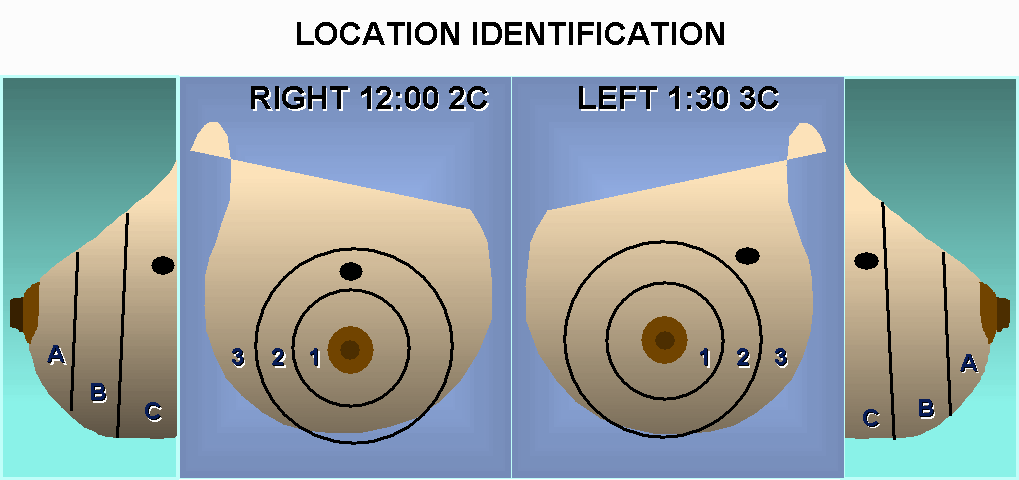
Diagram of a right breast lesion about 4 cm directly superior to the nipple and 3 cm deep which was scanned in a radial plane would typically be described as "Rt 12 2C RAD". The left breast lesion in the upper outer quadrant about 6 cm from the nipple and near the chest wall which was scanned in an anti-radial plane would be labeled "Lt 1:30 3C AR". This cryptic method of annotating ultrasound images is very advantageous. It saves keystrokes and shortens the examination time.
Positioning
The patient is positioned in a supine position with the ipsilateral hand raised above the head. The patient is rolled into a contra-lateral posterior oblique position to a degree, which minimizes breast thickness in the quadrant being scanned. Lesions in the medial quadrants may be scanned in a straight supine position. Lesions in the lateral quadrants require the greatest degree of obliquity. Generally, greater degrees of obliquity are required for larger breasts.
This positioning accomplishes two things:
- First, the breast is thinned to the greatest extent possible, so that the high frequency, near-field probes used, has adequately penetrate to the chest wall and the focusing characteristics of the probe are optimized.
- Secondly, the tissue planes of the breast, which are conical in the upright and prone positions, are pulled into a plane, which is parallel to the skin line. This minimizes critical angle shadowing and improves penetration and prevents degradation of focusing characteristics.
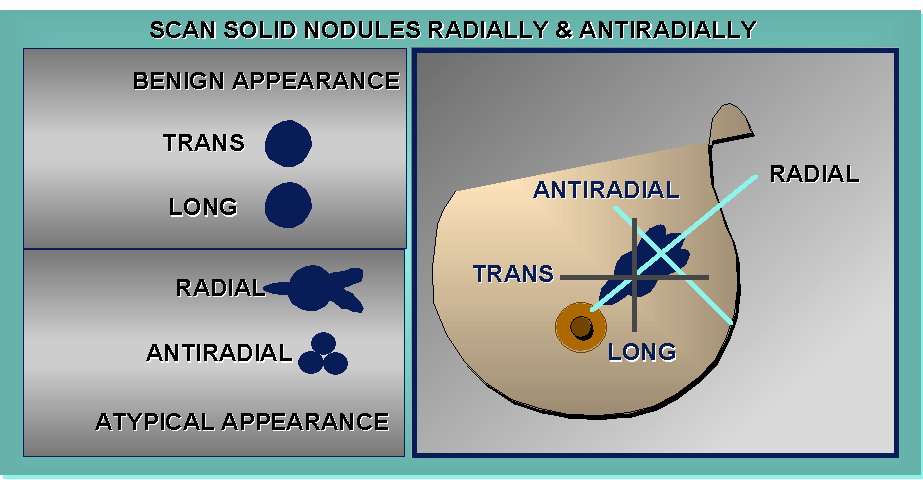
Scan Plane – Radial and Anti-radial
All solid lesions should be scanned in the plane of the ductal system (radial and anti-radial) in order to demonstrate subtle projections that course towards the nipple or branch outward in the breast.
If a nodule is scanned only in the conventional method of longitudinal and transverse, these subtle findings may be missed, and the lesion may appear spheroid or ellipsoid, and be misclassified as probably benign.

System Optimization
Ensure that your system is optimized for breast imaging before starting your scan. If the gain is not set correctly, solid lesions can look cystic or a cyst look solid. Before starting to scan the area of interest, find an area in the breast with fatty tissue. Most patients have some fat, usually in the inner aspect of the breast. Set your gain so the fat is medium gray.
Compare all lesions in the breast to fat. If the gain is set correctly and fat is medium gray, glandular tissue and most benign lesions, such as fibroadenomas, appear isoechoic to mildly hypoechoic compared to fat. Malignant lesions can be mildly hypoechoic to markedly hypoechoic and cysts are markedly hypoechoic to anechoic compared to fat. The structures that are hyperechoic compared to fat are skin, fibrous tissue and calcifications.
Mammographic vs. Sonographic Correlation
When the main indication for breast ultrasound is a palpable lump, it is imperative that the lump be palpated while scanning. A breast biopsy can be avoided if it can be shown that the lump is due to a simple cyst or normal fibroglandular tissue. Both can cause palpable lumps. Simple cysts are so common in some age groups that they are virtually a variant of normal. Fibroglandular tissue is present in at least some part of the breast, in the majority of all women -- especially those who are within the reproductive years and even in postmenopausal women who are undergoing hormonal replacement therapy
When the main indication for breast ultrasound is a mammographic nodule, mass, or focal asymmetrical density, it is essential that size, shape, location, and density of surrounding tissues are the same on mammograms and ultrasound. As for the palpable lumps, merely showing a simple cyst or focal collection of fibroglandular tissues does not prove that either is the cause of the mammographic abnormality. Either could easily be an incidental finding, especially if the breasts are mammographically dense or if there are multiple mammographic densities. Only if the size, shape, location, and density of surrounding tissues are similar on mammography and sonography, are we sure that a simple cyst or fibrous pseudo-tumor is the cause of the mammographic density
When correlating breast ultrasound with mammography, one should compare the CC view of the mammogram with the transverse view on ultrasound. The shape of a mammographic lesion will be easier to reproduce sonographically if the scan plane is identical to the projection plane of the mammogram. The MLO view of the mammogram may vary from 30o to 60o. It is difficult to reproduce the exact degree of obliquity on the ultrasound that was used on the MLO view of the mammogram.
Normal Sonographic Anatomy

The skin is hyperechoic and approximately 2mm thick. The subcutaneous fat is seen anterior to the pre-mammary fascia. Cooper’s ligaments may be seen as hyperechoic bands coursing through the subcutaneous fat. The mammary zone is where the majority of breast cancers, detectable by ultrasound, are located. Posterior to the mammary zone is the retro-mammary fascia and fat. And the most posterior structure is the pectoralis muscle and then the lung.
Cysts
Breast cysts, like cysts elsewhere in the body, can be classified as either simple or complex.
Simple Cysts
Strict criteria for a simple cyst include:
- anechoic center
- thin echogenic capsule
- enhanced through transmission
- thin edge shadows
Cysts which strictly meet these criteria can be classified as simple and have virtually no chance of containing malignancy. They do not need to be aspirated (unless they are causing discomfort or are preventing adequate mammographic compression and evaluation) and they do not need short-interval follow-up. While malignancy inside a simple cyst is virtually unknown, carcinoma can occur in the immediate vicinity of a cyst, so it is necessary to survey the tissues surrounding the cyst as well as the cyst itself.
Complex Cysts
All cysts that do not meet strict criteria are, by default, classified as complex cysts. However, the term complex breast cyst does not carry the significance of a complex cyst of the kidney or liver. It is important to understand that complex cystic breast malignancies are extremely rare, and usually have other features, which are obviously malignant. The vast majority of complex cysts fall within the broad spectrum of fibrocystic change. For these reasons, the majority of complex breast cysts are not worrisome, and do not need to be aspirated or biopsied.
With the improved resolution of current high-end equipment, a large percentage of breast cysts appear "complex". This is because there is real "stuff" within most breast cysts, due to fibrocystic change. With older equipment these internal cells and debris were not visible, and the cysts appeared simple. Internal contents within breast cysts are part of the spectrum of fibrocystic change and include:
- protein globs
- cellular debris
- cholesterol crystals
- foam cells
- apocrine cells, floating and papillary
It is necessary, therefore, to have a method of evaluating the relative risk of an individual complex breast cyst for two complicating factors:
- infection
- malignancy
Categorizing complex cysts into categories can help assess their risk of infection or neoplasm. Complex breast cyst categories include:
- diffuse low level internal echoes
- fluid-debris levels
- septations
- eccentric wall thickening
Low Level Internal Echoes & Wall Thickness
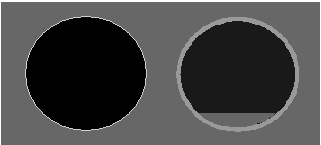
Thin - echogenic wall / Thick – isoechoic wall
Complex cysts with low-level diffuse internal echoes should be evaluated for wall thickness and particle mobility. Determine if the cyst has a normal thin, echogenic wall or a uniformly thickened, isoechoic wall which indicates inflammation. A cyst with a thickened wall should be considered acutely inflamed, potentially infected, and should be aspirated.
If the cyst with low level internal echoes does not have a thickened wall, then the size of the internal particulate matter should be evaluated. Complex cysts with diffuse low-level internal echoes can contain either light, subcellular particles or heavier cellular particles these subcellular particles are merely part of the spectrum of fibrocystic change, and are not worrisome.
Fluid Debris Level
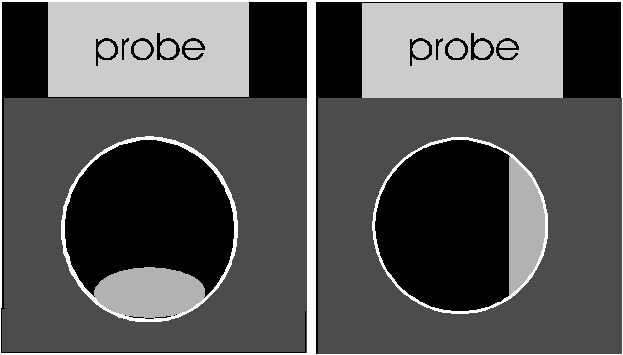
Supine Upright / Decubitus
Cysts with fluid-debris levels often also have a uniformly thickened wall indicating acute inflammation and are often tender. The position of the debris level within such complex cysts will shift with changes in patient position in a manner similar to the movement of sludge within a gallbladder. When a fluid debris level is suspected, the cyst should be evaluated in left lateral decubitus or upright position, as well as in the usual supine position. Complex cysts with fluid debris levels should be aspirated.
Septations
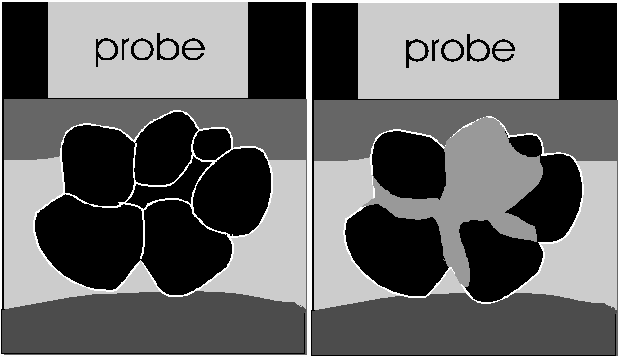
Thin Septations Thick Septations
The majority of thinly septated cysts can be more precisely defined as clusters of simple cysts or as a large simple cyst with normal tissue indenting it. These do not need to be aspirated or even followed. They should be considered to be simple cysts.
Complex cysts with thick septations should undergo further diagnostic evaluation. Aspiration alone is insufficient, the risk of false negative cytology is too high. Additionally, should the cyst be aspirated and the cytology later found to be atypical or malignant, it may be difficult to find the lesion again for needle biopsy or needle localization unless the fluid reaccumulates. If aspiration is performed, one should be ready to follow aspiration immediately with large core needle biopsy.
Eccentric Wall Thickening
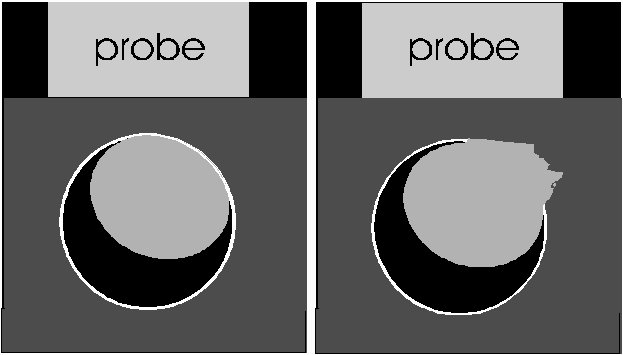
The appearance of the cyst capsule immediately adjacent to the eccentric wall thickening is very important. Complex cysts containing papillomas or papillary carcinoma, more frequently have an irregular, angular outer margin and lack the smooth thin echogenic capsule. For the purposes of evaluating surface characteristics, the eccentric wall thickening is assumed to be a solid nodule within a cyst. As in solid nodules, the smooth, thin, echogenic capsule indicates a non-infiltrating, pushing leading edge, more typical of benign lesions. The lack of a thin capsule increases the likelihood of an infiltrating leading edge, a sign of malignancy.
Implants
Complications of mammary implants can occur immediately after surgery and be acute, or may occur months to years after surgery and cause long-term problems.
Acute complications include:
- bleeding
- infection
- asymmetry
- loss of nipple sensation
- pain and tenderness
Long term complications include:
- capsular contracture
- rupture
- intracapsular
- extracapsular
- hematoma
- herniation
- migration
- chronic infection
The goals of imaging in patients with breast implants are two-fold: evaluation of breast tissues and evaluation of implants for complications.
Evaluation of implants may be the primary or secondary goal of sonography. If the patient has a palpable lump or mammographic abnormality for which sonography is indicated, the chief complaint should be evaluated first. Only after the problem for which the sonogram is indicated is solved, should evaluation for implant complications be undertaken.
Normal Sonographic Implant Appearance
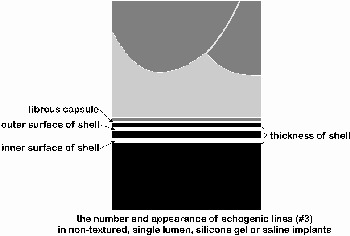
At sonography a difference in the thickness and echogenicity of the elastomer membrane of smooth and textured implants is apparent. Smooth membranes appear thinner, more echogenic, and more sharply delineated than do textured implants. The appearance of thin, smooth membranes will vary, depending upon probe frequency. With 5 to 7.5 MHz transducer, the shell will usually be seen as a single echogenic line. With the better axial resolution of a 10-13 MHz, transducer, the inner and outer surfaces of the shell may each create an echogenic line separated by a lucency, which represents the thickness of the shell.
Implant Rupture
Intracapsular Rupture
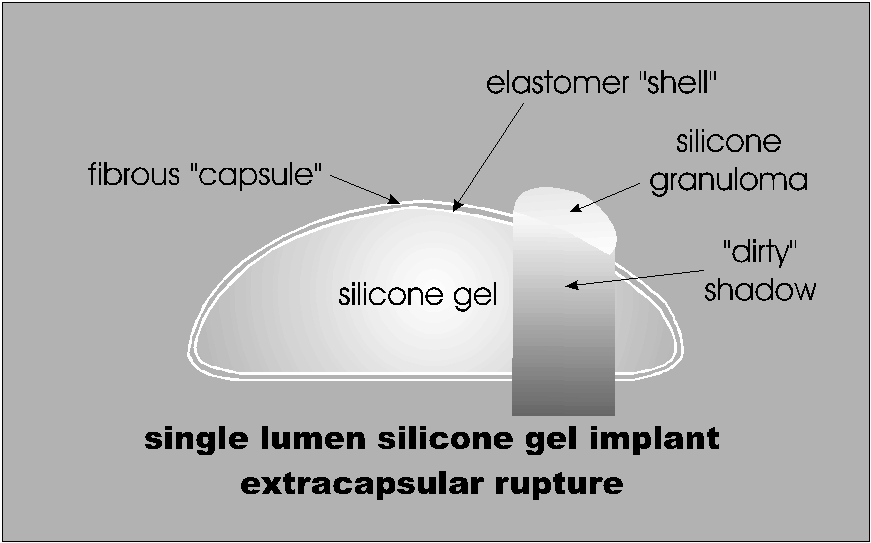
Intracapsular implant ruptures occur when there is a breach in the elastomer membrane around a single lumen silicone implant and silicone escapes from the implant, but is still confined within the fibrous capsule around the ruptured implant.
Folds of the collapsing elastomer membrane may be seen as a series of thin, double echogenic lines which course parallel to the probe face. This has been called the "stepladder sign" in sonographic literature counterpart to the MRI finding called the "linguini sign".
Extracapsular Rupture
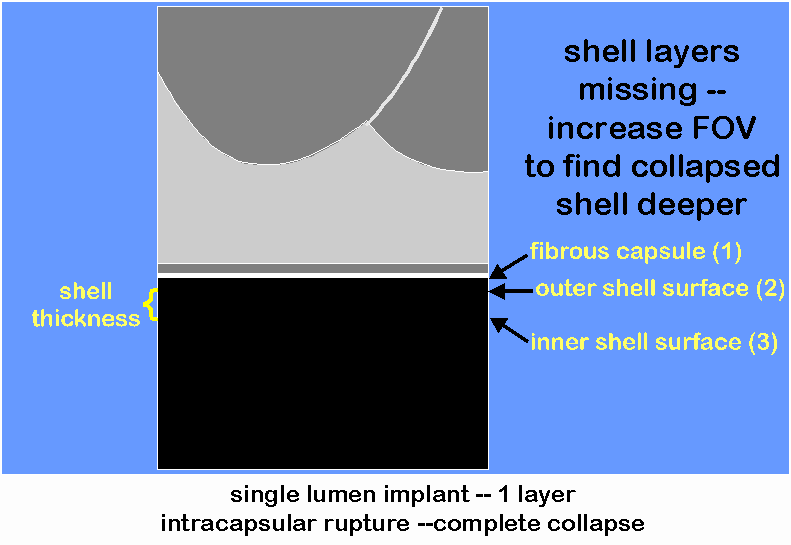
The hallmark of extracapsular rupture is the presence of macroscopic amounts of silicone outside the implant and also outside the fibrous capsule surrounding the implant. The presence of extracapsular silicone implies that there is also intracapsular rupture. Silicone within the soft tissues of the breast is rapidly walled off by inflammatory response and forms a silicone granuloma. The classical sonographic description of silicone granuloma is that of the "snowstorm" appearance, which causes "dirty" shadowing posteriorly and obscures the posterior border.
It is also necessary to scan the tissue peripheral to the edge of the implant as well as those anterior to the implant. In our experience, more patients have silicone granulomas in the soft tissue peripheral to the implant than in the breast tissue directly anterior to the implants. The majority of extracapsular ruptures are seen in the upper outer quadrants.
Counting the number of echogenic lines is most valuable in patients where there is a question of intracapsular rupture with incomplete collapse of the implant. Single lumen silicone gel implants should have 3 closely apposed echogenic lines at the anterior surface of the implant – 1 representing the fibrous capsule, the 2nd representing the anterior surface of the shell and the 3rd representing the posterior surface of the shell. In cases of extracapsular rupture there will either be only a single echogenic line representing the fibrous capsule if collapse is complete or there will be an abnormal separation between the echogenic line representing the fibrous capsule and the 2nd echogenic line representing the anterior surface of the shell.
Solid Nodules
All solid nodules should be considered worrisome and malignant findings sought, and recorded as being present or absent. If a single malignant feature is present, the nodule can not be classified as benign. If no malignant features are found, specific benign features then need to be sought. Only if benign findings are found, can the nodule then be classified as benign. If specific benign features are not found, the lesion should be classified, by default, as indeterminate.
Malignant Findings
Individual sonographic criteria are:
- spiculation
- taller-than-wide (larger AP than transverse dimensions)
- angular margins
- markedly hypoechoic (compared to fat)
- shadowing
- calcifications
- duct extension
- branch pattern
- microlobulation
- disruption of tissue planes
Benign Findings
Individual benign criteria (all are smooth and well-circumscribed)
- absence of any malignant findings
- markedly hyperechoic (compared to fat)
- ellipsoid shape
- 3 or fewer gentle lobulations
- thin, echogenic capsule
Ultrasound BIRADS Chart
(breast imaging reporting and data system)
Color Doppler
Color Doppler is often used in breast ultrasound to look for neovascularity. We do not use color Doppler to tell benign from malignant nodules; we use it more to help distinguish solid from cystic lesions. If there is a question about a lesion being a complex cyst vs. a solid nodule, we will look for the presence of flow. If there is no flow it does not mean that the lesion is a cyst, but if there is flow then you know it is a solid lesion. We have found that by applying slight pressure all flow in a lesion can be temporarily ablated. If you are looking for the presence of flow remember to scan with very light pressure. Some uses for color Doppler include:
- solid vs. cystic – fibrovascular stalk
- inflamed vs. non-inflamed
- inflamed vs. tumor
- anatomic landmark – int mamm LN
- IDP vs. inspissated secretions
- normal from abnormal tissue – Fremitus
Fremitus
Fremitus is a thrill of the chest wall. Using Power Doppler and having the patient hum, or say eee, the tissues around a lesion will vibrate and create a power Doppler signal, the lesion will be void of the power Doppler signal. Some have reported that this helps differentiate benign from malignant lesions. We use it for telling;
- fat from true solid nodule
- artifactual shadowing vs. true
- multifocal vs. unifocal disease
Conclusion
Breast Ultrasound is a valuable tool in the diagnosis of breast disease. Most examinations are targeted at nonspecific, clinical or mammographic abnormalities. Breast sonography is extremely operator dependent, it is essential to use the appropriate equipment and be properly trained in breast imaging to achieve a more specific diagnosis.
Would you like to comment on this article? This link will open your email program with the subject line completed and the url of the article you are commenting on in the body of your message.
References:
Radiology Imaging Associates - Swedish Medical Center
Englewood, Colorado
Reprinted with author's permission.
Take the exam for CME Credits from SDMS
From: Official Proceedings - Society of Diagnostic Medical Sonography's 17th Annual Conference.September 14-17, 2000, Dallas Texas, p. 57-67
Integrating HCV screening with breast cancer programs enhances care
June 25th 2024A recent study from France demonstrates that incorporating hepatitis C virus screening into breast cancer programs significantly improves patient engagement and access to effective antiviral treatments among older women.
Read More
